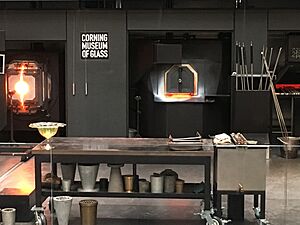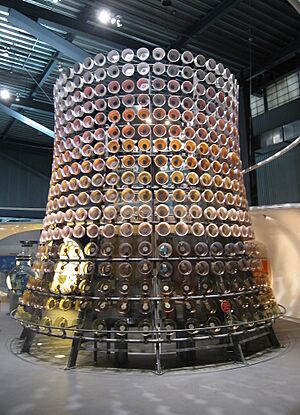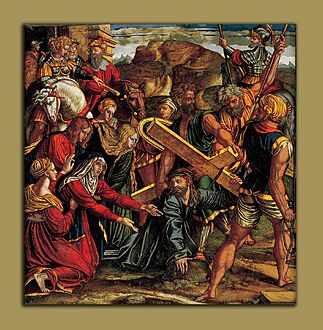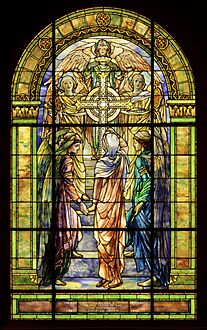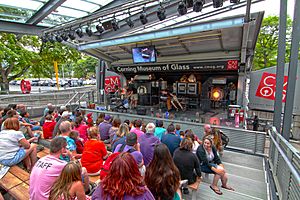Corning Museum of Glass facts for kids
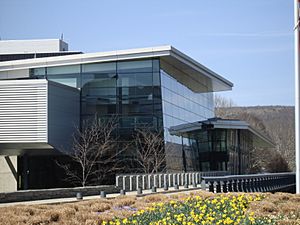 |
|
| Established | 1951 |
|---|---|
| Location | Corning, New York, United States |
| Visitors | 400,000 (2012) |
The Corning Museum of Glass is a special museum in Corning, New York. It teaches visitors all about glass: its art, its long history, and the science behind it. The museum was started in 1951 by a company called Corning Glass Works. Today, it holds more than 50,000 glass items. Some of these amazing pieces are over 3,500 years old!
Contents
Museum History
The Corning Museum of Glass, often called CMOG, is a museum that focuses on glass. It was first created in 1951 as the Corning Glass Center. The Corning Glass Works company built it to celebrate their 100th birthday. Thomas S. Buechner was the first director of the museum. He led the museum from 1951 to 1960 and again from 1973 to 1980.
Museum Growth and Changes
The first museum building was designed in 1951. Later, a new part was added and opened in 1980.
A special area called The Studio opened in 1996. Here, people can take classes to learn about glass.
The museum was updated in 2001 with new ways to show off its collections.
In 2012, the museum grew even more. A new section, the Contemporary Art + Design Wing, opened in March 2015. This wing shows modern glass art and designs.
Karol Wight has been the museum's executive director since 2011. She became its president in 2015.
In October 2024, The Studio expanded significantly. It grew from about 24,000 square feet to 60,000 square feet. This expansion provides more space for artists and students. They can stay for short or long periods to work on glass projects. The Residency Center also has a Glassmaking Institute. This institute offers a two-year program for learning glassmaking.
The 1972 Flood
In June 1972, a big storm called Hurricane Agnes caused a lot of damage. The museum was badly hit by the floodwaters. Many rare books were covered in mud and broken glass. About half of the library's entire collection was damaged. Also, 528 of the museum's 13,000 glass objects were harmed.
During the cleanup, the library moved to an old grocery store. Staff and volunteers worked hard for two years. They dried, cleaned, and fixed over 7,000 wet books. Special experts helped restore the very rare books. The museum reopened on August 1, 1972, even while repairs were still happening.
The Glass Collection
Museum Galleries
The museum has many amazing glass artworks by famous artists. Some of these artists include Lino Tagliapietra and Dale Chihuly. The museum's galleries show glass from different times and places.
Some of the galleries you can explore are:
- Glass in Nature
- Origins of Glassmaking
- Glass of the Romans
- Glass in the Islamic World
- Early European Glass
- The Rise of Venetian Glassmaking
- Glass in 17th–19th Century Europe
- 19th Century European Glass
- Asian Glass
- Glass in America
- Corning: From Farm Town to "Crystal City"
- Paperweights of the World
- Modern Glass
There are also special galleries like the Jerome and Lucille Strauss Study Gallery. The Ben W. Heineman Sr. Family Gallery of Contemporary Glass is another important one. It shows how glass is used in art, crafts, and design. This gallery features works by international artists from 1975 to 2010.
Special Exhibitions
The CMOG always has new and exciting exhibitions throughout the year. These shows might focus on a specific artist or a big topic in glass history. For example, past exhibitions have explored Medieval Glass and how glassmaking ideas traveled between East and West.
The Rakow Commission
Since 1986, the museum has supported new glass art through the Rakow Commission. This program gives money each year to artists. It helps them create new glass artworks. These new pieces are then added to the museum's collection. They are shown to the public for the first time at an annual event.
Selected Collection Highlights
Glassmaking Demonstrations
Visitors to the museum can watch glass being made live. You can even learn to make glass yourself!
Hot Glass Show
The museum offers several live glassmaking demonstrations. The Hot Glass Show is very popular. During this show, a glassblower shapes hot, melted glass. Another glassblower explains what is happening.
The Hot Glass Show happens every day at the museum. It is included with your admission ticket. The glassmaker takes a glowing blob of molten glass. They then shape it into vases, bowls, or sculptures. Cameras give you a close-up view of the furnaces where the glass is heated. This show teaches you about an ancient Roman technique still used today. Each show lasts about 20 to 40 minutes. The museum also takes the Hot Glass Show on the road. They bring the amazing demonstration to other places and events.
GlassLab Program
GlassLab is a special design program at the museum. It helps designers and artists explore new ways to use glass. The program is by invitation only. It gives designers a chance to try out new ideas with glass. These designers come from many fields, like product design or fashion design. In public "design performances" or private workshops, designers and glassmakers work together. They create new glass designs and test them out.
Many famous artists and designers have been part of GlassLab. Some names include the Campana brothers and Arik Levy.
Research and Library
The museum does a lot of research about glass. It also publishes books and gives talks on many glass topics. The museum is home to The Rakow Research Library. This library has a huge collection of materials about glass art and history. It is open to everyone.
Rakow Research Library
The Rakow Research Library started with the museum in 1951. It is a public library with a very complete collection on glass. You can find everything from old medieval writings to modern art on paper. It also has the latest information on techniques used by glass artists today.
The library has over 130 special collections. These include unique materials from artists, galleries, companies, and scholars. The library also puts on exhibitions to show off rare items from its collection. In 1985, the library was renamed the Leonard S. and Juliette K. Rakow Library. This honored Dr. and Mrs. Rakow, who were big supporters of the museum.
You cannot check out books from this library. However, it is part of a big international library network. This means you can borrow copies of books or articles through your local library.
See also
 In Spanish: Museo Corning del Vidrio para niños
In Spanish: Museo Corning del Vidrio para niños


